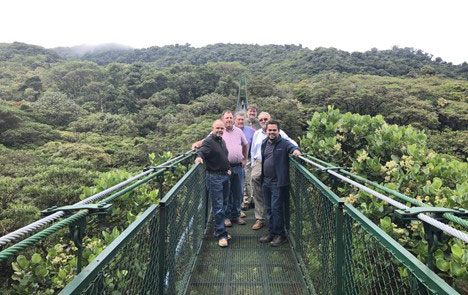 The International Rice Leadership Class on cloud nine in Costa Rica
The International Rice Leadership Class on cloud nine in Costa Rica
Dec 06, 2022
By David Martin
David is third-generation rice farmer and a partner in Martin Farms and Martin Rice Company, headquartered in Bernie, Missouri.
BERNIE, MO – As soon as we arrived in San José, Costa Rica, we were met by Roberto Camacho, a Costa Rican native, who had studied rice production with Dr. Steve Linscombe at Louisiana State University. Roberto would be our guide and translator throughout the trip.
We stopped several times on the long drive from San José to the west coast. First, for lunch at a popular spot called El Jardin, and next at the container port of Caldera, the main offloading site for rice in Costa Rica. We also shopped at Maxi Pali, a supermarket chain owned by Walmart, that stocked one exclusive brand of rice.
The next day we visited the Monteverde Cloud Forest Biological Preserve, an area renowned for its diverse and exclusive flora and fauna. We toured the nearby Don Juan Plantation that grows coffee, sugarcane, and cacao, and participated in demonstrations of how all three crops are processed. We then traveled out of the mountains and into the plains on the Pacific side to a rescue ranch for wild animals native to Costa Rica.
At the Paso Hondo Farm, rice farmer Fabricio Ulate talked about production practices on his operation including experimentation with input efficiency. At Hacienda Mojica, once one of the biggest cattle ranches in Costa Rica, we met with the owner and his farm manager who explained how they got into rice production after the federal government formed an irrigation district and created an extensive canal delivery system.
Not far from the port of Caldera, we toured the Interglo Rice Mill that mills exclusively for Walmart-branded stores. Almost everything bagged there was under the brand Indiana, the rice we saw in the grocery store on our first day. All the rice we saw in Costa Rica was marketed by percentage of whole kernels, going from 95 percent, down to 80 percent, with the lower percentage of whole kernels being a lesser quality of rice by appearance.
The day we crossed into Panama we got an early start trying to beat the rush of truck drivers and others at the border. Our Panamanian tour guide, Alexander Arauz, a rice farmer, took us to a farm with rain-fed rice production. As we were standing in the rice field, I kept hearing a roaring noise that was the sound of the ocean – we were within one kilometer of a beach!
Alexander had set up an impromptu visit to Industrial Arrocera, a mill he delivers his rice to, where we met Ivan Quintero who talked about ongoing quality issues that all of Central America is having with U.S.-grown rice. Costa Rica and Panama enjoy a large per capita consumption of rice by discriminating consumers who expect a certain quality. This is an issue that the U.S. industry must address or we will continue to lose ground in the region.
On our final day, we went to the Panama Canal where we boarded a small fiberglass boat that took us to the Miraflores Locks. Coincidentally, it was Panamanian Independence Day, and a large crowd had gathered to watch the ships moving through the locks accompanied by a band playing traditional Panamanian music.
In closing, I would like to thank the International Leadership Program sponsors, John Deere, American Commodity Company, and RiceTec, for their generous support. It’s a tremendous opportunity and really does give you a better understanding of the challenges faced by agriculture around the world. It also lets us know what we as an industry can do to fix problems and bridge gaps wherever they may be.